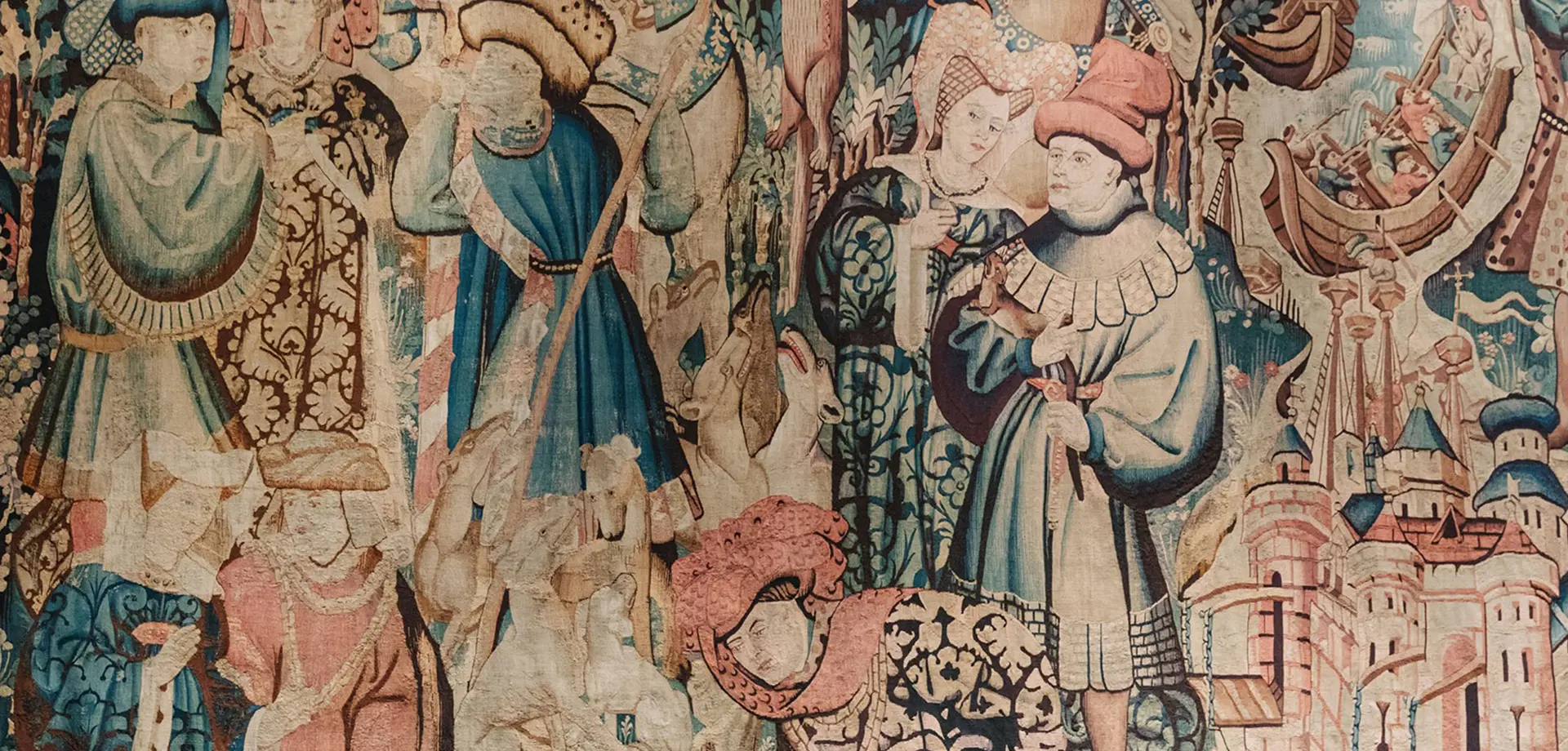In this second instalment of a two-part blog, Lucy Brownson reflects on the time that the Devonshire Hunting Tapestries were with us at Chatsworth, exploring the history of the tapestries and showing how the legacy of such a major loan lives on in our research.
Last year two of the Devonshire Hunting Tapestries travelled from the V&A Museum to Chatsworth, where they were greeted by Frances Hartog, Senior Textile Conservator at the V&A, Textiles Supervisor at Chatsworth, Susie Stokoe, and a small army of conservation assistants, technicians and housemen.
It was all hands on deck for the formidable task of unpacking and exhibiting these nearly 600-year-old tapestries safely – but how does one move and hang 50kg of fragile, intricately woven wool (twice over, no less)?
In the weeks leading up to the tapestries’ arrival, the team began by clearing away the obstacle course of Italian sculpture that usually occupies the Sculpture Gallery, before erecting four 4.5-metre scaffold towers for the team to stand on whilst the tapestries were unrolled onto the walls.
The riskiest part of the whole endeavour was unpacking the tapestries, working together very, very slowly to unroll each tapestry from its transport roller and re-roll it onto a lighter installation roller, as Susie checked the warp and weft of the fabric with eagle-eyed precision. The install of the Hunting Tapestries went off without a hitch but it could’ve easily been a different story. These tapestries could have met a markedly different fate.
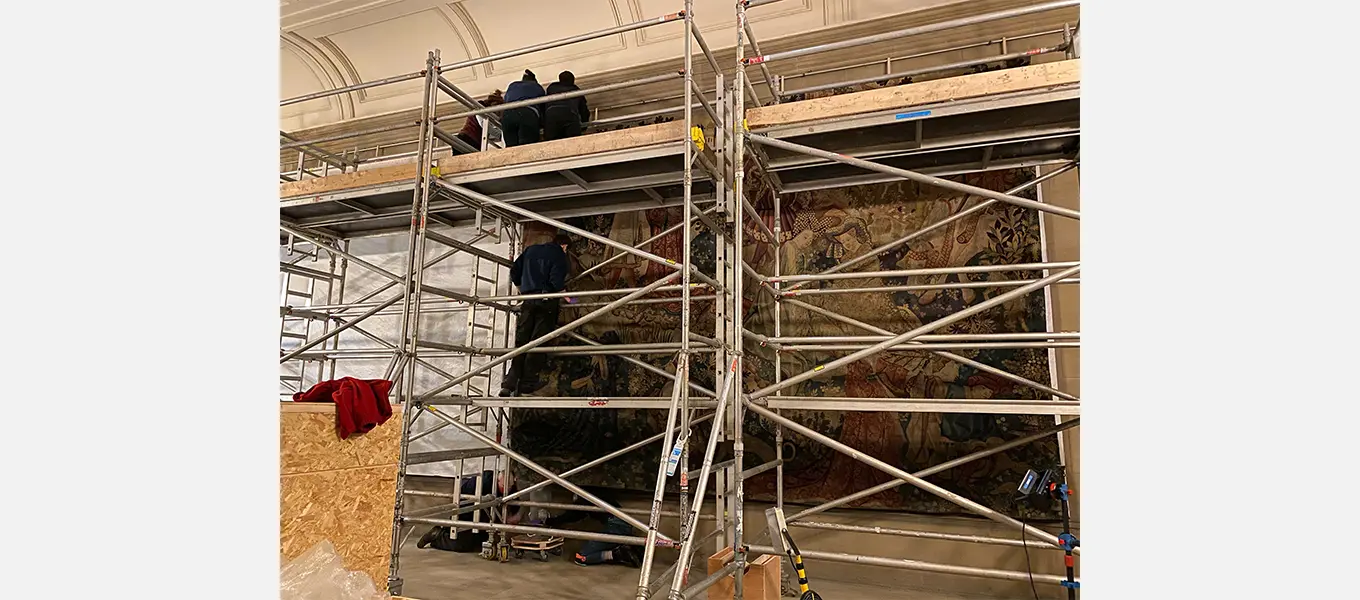
Installing one of the Devonshire Hunting Tapestries in the Sculpture Gallery. © Chatsworth House Trust.
You’ll remember from our last blog that the Devonshire Hunting Tapestries were in literal bits and pieces when they were rediscovered at Hardwick Hall in 1899, having been cut up and repurposed as insulation in the cavernous, draughty Long Gallery. After almost a decade of painstaking restoration, the tapestries were back to their former glory – yet forty years down the line, in 1950, Duchess Evelyn Cavendish wrote to Chatsworth with concerns that they were again in disrepair, suspecting they’d been subject to ‘some very rough handling’. What happened in the years between these two events?
The story of the Devonshire Hunting Tapestries’ fall and rise is one that speaks to the changing fortunes of the British country house – so in this blog, we’ll explore the tapestries’ recent history as told by the duchess who documented it all.
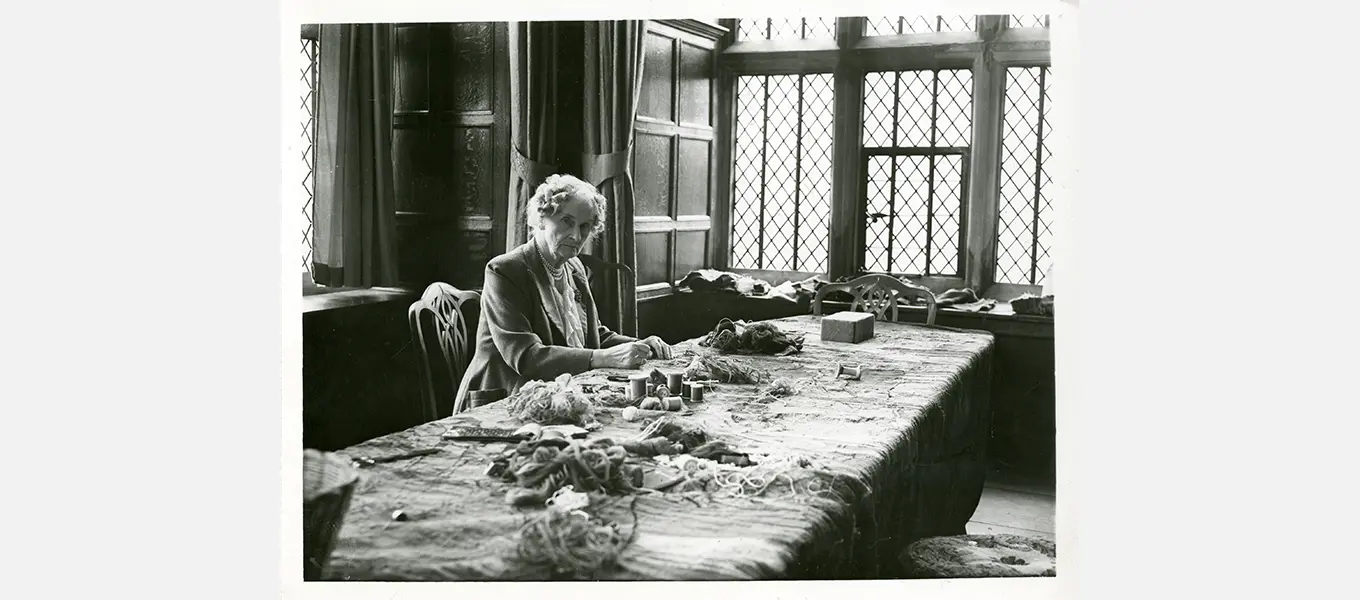
Evelyn Cavendish, Duchess of Devonshire, engaged in needlework at Hardwick Hall (c.1950s). Credit: Devonshire Collection Archives.
‘The glory of the Sculpture Gallery is not the sculpture, but the tapestries, which have lately been brought back from Hardwick,’ declares the 1910 Guide to Chatsworth. Written by Eugénie Sellers Strong, Chatsworth’s first female Librarian, this guide offered an intellectual history of the rooms and artworks along the visitor route; in the Sculpture Gallery, it supplies a detailed (if dry) description of the 6th Duke’s sculpture collection and the Hunting Tapestries that then, as now, adorned the walls.
Having been conserved by the Decorative Needlework Society at South Kensington Museum (now the V&A), the tapestries came to Chatsworth around 1908, and the Sculpture Gallery – being one of the largest rooms in the house – was just about the only place large enough to exhibit them. Duchess Evelyn Cavendish explains the rationale for hanging the tapestries here in her Handbook to Chatsworth (unpublished; c.1924):
‘We were quite conscious that this classical hall did not suit them, but there was really no choice in the matter. I therefore moved as much of the modern sculpture as possible out of the gallery and think that – when the men have the time to do it – we might get [the remaining sculptures moved] so as to leave the tapestry in possession of the main parts of the gallery.’
A skilled embroiderer and self-taught conservator, Duchess Evelyn was eager that the Hunting Tapestries should take centre stage in the Sculpture Gallery. Napoleon’s sister in milky white marble, Antonio Canova’s Sleeping Endymion reposing on his plinth, the iconic Chatsworth lions that now flank the room’s far entrance – all were relegated by the Duchess to the Orangery, the adjoining glass structure that weathered the citrus through the Derbyshire winters. Like so many spaces at Chatsworth, the Orangery has led many different lives – today, it’s the gift shop at the end of the visitor route.
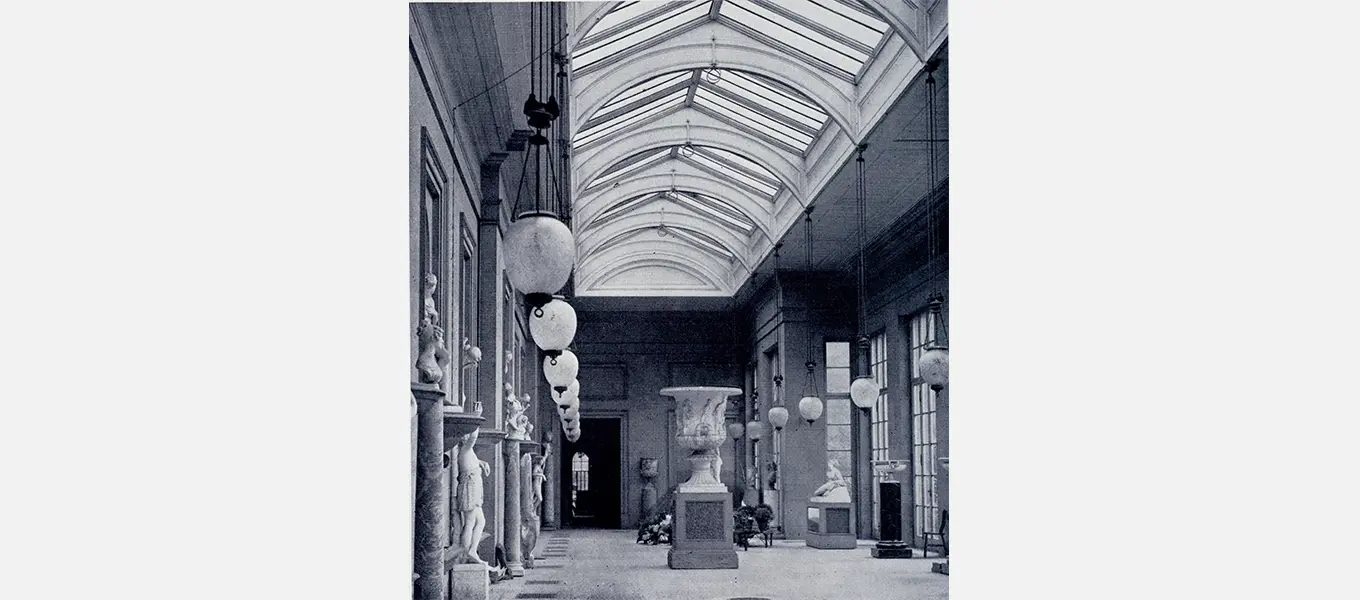
The Orangery (now the gift shop) with sculptures (c. late 1800s). Credit: Devonshire Collection Archives.
The Devonshire Hunting Tapestries remained in the Sculpture Gallery until the outbreak of the Second World War, which saw the arrival of 250 schoolgirls, 36 teachers and 26 pianos when Chatsworth became home to Penrhos College, an all-girls’ boarding school. Just before the girls arrived, librarian Francis Thompson had the prescience to put the tapestries into storage – a wise move, given the discovery of chocolate wrappers that a schoolgirl had hastily stuffed into one of the Mortlake tapestries. Despite Thompson’s prudence, though, the Hunting Tapestries still sustained damage, as Duchess Evelyn noted of the Boar and Bear Hunt:
‘What can have happened to [it]? When I left Chatsworth [in 1938] there was not a hole or split in it… Did it by chance get damp during the war – or too dry?’
- Letter from Duchess Evelyn Cavendish to Francis Thompson, 25 July 1950
Whatever the reason, by the end of the war the tapestries were in dire need of TLC. George Wingfield Digby, the V&A’s textile curator, assessed the tapestries in October 1948 and reported that they were discoloured, dirty, and suffering from the earlier restoration by the Decorative Needlework Society. New methods were needed, Digby concluded, to clean the tapestries, reweave some sections, and transform them to a ‘really first-class’ state.
Duchess Evelyn was less enthusiastic about Digby’s proposal, remarking that it’d be ‘ruinously expensive’ to get a single tapestry restored and warning against the chemical treatments he recommended. She doubted whether the Chatsworth Settlement Trust had the money – much more than the tapestries were worth at that point – to pay for restoration. The stymied tourist trade and deep recession brought about by the war had hit Chatsworth and many other country estates hard, meaning that an economical approach must be taken.
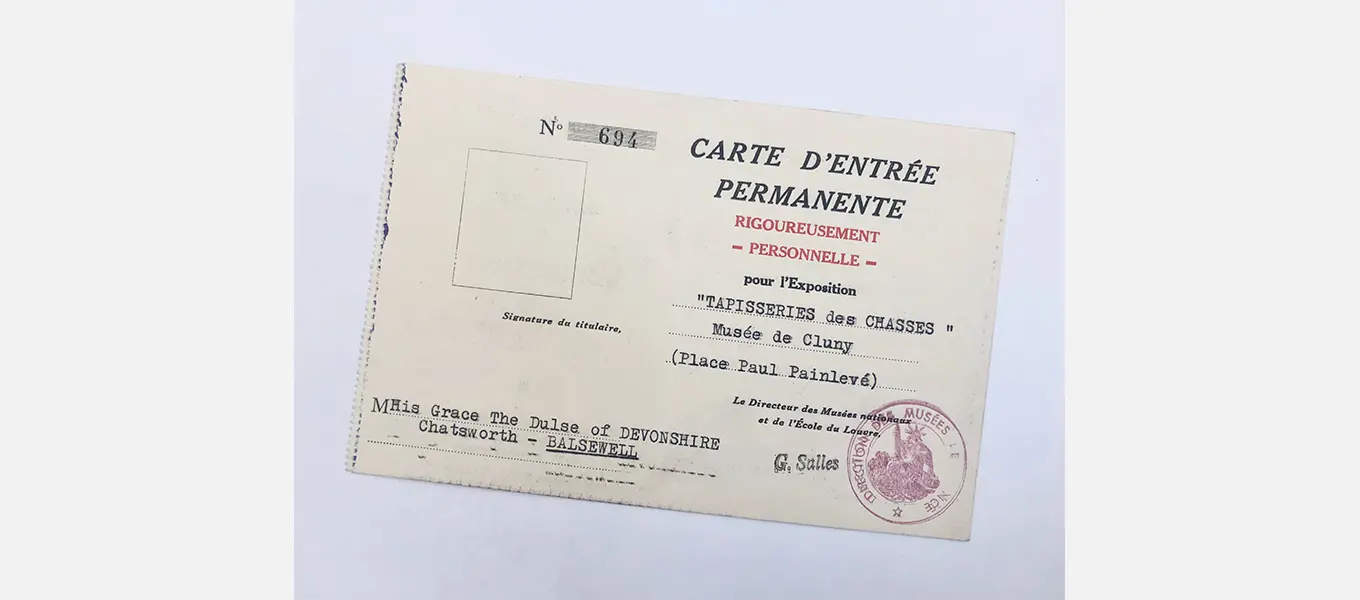
Admission ticket for the exhibition of the Deer Hunt at the Musée de Cluny, Paris (1950). Credit: Devonshire Collection Archives.
Despite their fragile state, the Hunting Tapestries were retrieved from storage and loaned to two major exhibitions after the Second World War: Falconry was part of the 1949 French Landscape Exhibition at Burlington House, and the Deer Hunt went to the Musée de Cluny, Paris, in 1950. This latter tapestry remained in Paris for conservation by Pierre Verlet, a curator at the Louvre, and Duchess Evelyn again expressed scepticism about the conservator’s approach. When Verlet suggested that the Hunting Tapestries should be folded, the Duchess retorted that ‘any maid or housekeeper knows that such textiles may not be folded as they crack as if cut by a knife,’ instead suggesting that they be rolled on a drum.
Reader, she was right: had the Devonshire Hunting Tapestries been folded, they would have disintegrated into fragments. The Duchess was also right about the cost of conservation – it was indeed ruinously expensive, so much so that the Deer Hunt was the only tapestry to be conserved until the whole set was transferred to HM Treasury in lieu of death duties in 1957. Since then, they’ve been faithfully restored and cared for impeccably by the V&A, where they returned at the start of this year.
Following the Devonshire Hunting Tapestries’ history, tracing the hands through which they’ve passed, also yields a different story: that of the ebb and flow of family fortunes and grand country houses. When these tapestries were cut up and used as insulation at Hardwick Hall in the 1840s, they were considered worthless and unfashionable. When they were rediscovered and painstakingly restored six decades later, their rarity was recognised by the museum experts who were then beginning to professionalise conservation in country houses.
By 1950, estates like Chatsworth were again on shifting sands as the postwar recession and rising estate duties turned artworks into burdens and conservation into a luxury. 120 years after their rediscovery, the Devonshire Hunting Tapestries’ homecoming was a joyful one; restored to their former glory, they returned to Chatsworth, and were met in the Sculpture Gallery after so much time apart.
Read more about the Devonshire Hunting Tapestries on the V&A website.


